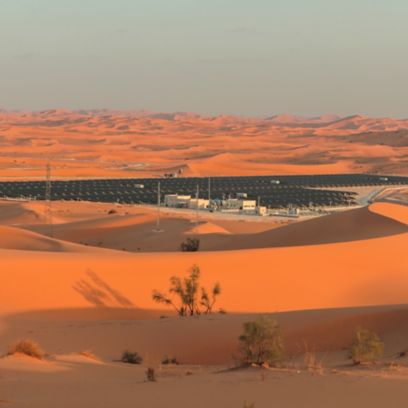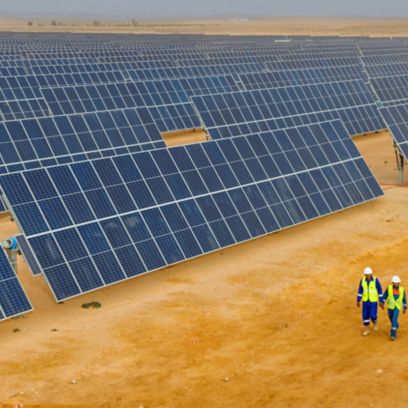1.7 mln
boe/d
daily production hydrocarbon

Or , our new artificial intelligence tool.
We continue to increase capacity in renewables to support the energy transition and achieve carbon neutrality.

Renewable energy refers to energy derived from sources that naturally replenish themselves within a timescale compatible with human life, making them inexhaustible, unlike fossil fuels. The main examples include wind, solar, hydroelectric and geothermal energy. Renewable energy sources also do not release greenhouse gas (GHG) emissions into the atmosphere during their use. Biomass and biofuels are also considered renewable sources because, although they emit CO2 when burned, this corresponds to the amount of CO2 absorbed from the atmosphere by the original biomass. Thanks to these characteristics, renewable energy plays a crucial role in the energy transition.
Renewable energy is a key element of our strategy for energy diversification. Increasingly integrating them into our energy mix contributes to achieving the Net Zero target, by offering products, services and solutions that are ever more decarbonised. To accelerate the development of new businesses in this sector, we have adopted our satellite model, which enables us to create independent companies and facilitate their access to specialised capital.
Plenitude gives concrete form to our commitment to progressively increase installed renewable capacity. It combines the production of electricity from wind and solar plants with the traditional sale of electricity and gas, energy efficiency services and electric mobility solutions.
By combining established conventional technologies with new solutions, we can offer an increasing production of electricity from renewable sources to households and businesses. Solar, onshore and offshore wind, storage and floating wind are the areas in which we operate in Italy and across the world. Through Plenitude we are present in Australia, France, Greece, Kazakhstan, Portugal, Slovenia, Spain, Norway, the UK and USA.
Our renewable energy plants are also applied in our upstream operations worldwide, helping to make them increasingly sustainable.
We anticipate growth in the production of energy from renewable sources (100% Plenitude).
installed capacity from renewables in 2028
installed capacity from renewables in 2030
installed capacity from renewables in 2035
installed capacity from renewables in 2050
installed capacity from renewables in 2028
installed capacity from renewables in 2030
installed capacity from renewables in 2035
installed capacity from renewables in 2050
The entry of new capital into Plenitude reinforces Eni’s position in renewables, retail and e-mobility, supporting the company’s long-term value creation and goals. The transaction further consolidates Eni’s satellite model, which involves the creation of companies focusing on business areas that are strategic for the energy transition while maintaining a strong presence in traditional activities. Thanks to their ability to attract fresh specialised capital, these companies operate with financial independence and accelerate the development of energy transition-related businesses, while remaining integral parts of the company.
Highlights Full Year 2024
daily production hydrocarbon
energy production from renewable sources (100% Plenitude)
adjusted cash flow
proforma adjusted EBIT
leverage proforma

We have introduced photovoltaics to power production activities with renewable energy.

The power plant can reach a maximum installed capacity of 10 MW and the solar tracking system optimises energy production.

The energy produced by the plant will be utilised in the adjacent field site.

If you want to change topic, clear the chat and make a new query to receive more relevant results.
This will delete the question history.
If you want to change topic, clear the chat and make a new query to receive more relevant results. This will delete the question history.
Here you can find the full list of your queries.
The answers are generated by artificial intelligence, therefore they may contain inaccuracies. Please read the terms and conditions of use.

EnergIA is an innovative tool based on artificial intelligence capabilities, which can help you navigate the contents of eni.com, quickly finding answers to your questions. EnergIA can also perform a search on a specific topic, providing the most up-to-date data available, or it can invite you to delve deeper into a topic of your interest by suggesting links and specific readings. Start now!
EnergIA is an innovative tool based on artificial intelligence capabilities, which can help you navigate the contents of eni.com, quickly finding answers to your questions. Start now!
EnergIA (ener'dʒia) is a system based on Generative Artificial Intelligence.
Thanks to this technology, we can respond to your requests by querying the most relevant content and documents available on eni.com. (Note: financial documents from the last 12 months and press releases from the last 2 years are considered.)
Through EnergIA, you can delve into topics of interest and have a real-time window into the world of Eni.
If you wish to search for a specific document, press release or news, use the traditional search engine via the magnifying glass icon.
Like all systems that leverage Generative Artificial Intelligence, EnergIA may generate inaccurate or outdated responses. Always consult the sources that EnergIA proposes as the origin of the generated information.
If the system fails to find an exact match for the requested content, it still tends to provide a response.
If you find any inaccuracies in the provided response, please send us your feedback at the bottom of the page: it will be very helpful for us to improve.
Remember that the content generated by the system does not represent Eni’s official position. We therefore invite stakeholders to refer to their designated contacts for official statements: Press Office for journalists, Investor Relations for analysts and investors, Company Secretariat for shareholders etc..
EnergIA can understand questions posed in almost all languages, but we prefer to provide you with a response in English or Italian, the two languages available on eni.com. If you ask a question in Italian, the content on the site in Italian will be consulted. If you ask it in English or any other language, the content in English will be consulted. (Note: the language Eni uses for financial documents/content is predominantly English.)
If questions are formulated that violate the set security criteria, the system will not proceed with processing the response. Please remember not to send personal data.
By using this service, the users acknowledge that they have read and accepted the terms and conditions of use.
Search
EnergIA (ener'dʒia) is a system based on Generative Artificial Intelligence.
Thanks to this technology, we can respond to your requests by querying the most relevant content and documents available on eni.com. (Note: financial documents from the last 12 months and press releases from the last 2 years are considered.)
Through EnergIA, you can delve into topics of interest and have a real-time window into the world of Eni.
If you wish to search for a specific document, press release or news, use the traditional search engine via the magnifying glass icon.
Like all systems that leverage Generative Artificial Intelligence, EnergIA may generate inaccurate or outdated responses. Always consult the sources that EnergIA proposes as the origin of the generated information.
If the system fails to find an exact match for the requested content, it still tends to provide a response.
If you find any inaccuracies in the provided response, please send us your feedback at the bottom of the page: it will be very helpful for us to improve.
Remember that the content generated by the system does not represent Eni’s official position. We therefore invite stakeholders to refer to their designated contacts for official statements: Press Office for journalists, Investor Relations for analysts and investors, Company Secretariat for shareholders etc..
EnergIA can understand questions posed in almost all languages, but we prefer to provide you with a response in English or Italian, the two languages available on eni.com. If you ask a question in Italian, the content on the site in Italian will be consulted. If you ask it in English or any other language, the content in English will be consulted. (Note: the language Eni uses for financial documents/content is predominantly English.)
If questions are formulated that violate the set security criteria, the system will not proceed with processing the response. Please remember not to send personal data.
By using this service, the users acknowledge that they have read and accepted the terms and conditions of use.
A new window into Eni’s world, at your disposal. EnergIA is an innovative tool based on artificial intelligence capabilities, which can help you navigate the contents of eni.com, quickly finding answers to your questions.


